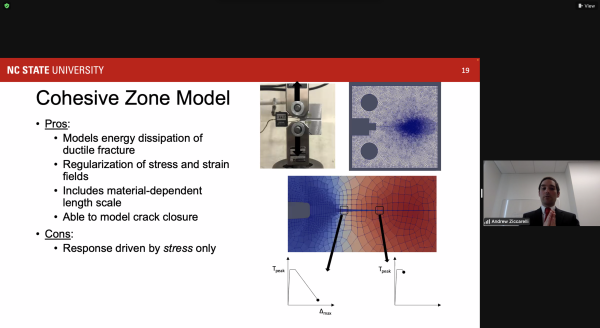
CCEE’s Structural Engineering and Mechanics (SEM) group held its 26th annual graduate research symposium on Feb. 25. With social distancing restrictions still in place, the event was held virtually and offered graduate students an opportunity to share their research. Nearly 40 people tuned into the symposium. This year’s keynote speaker was Dr. Andy Ziccarelli, a new assistant professor in the SEM group, who discussed the challenges and opportunities of high-fidelity simulations of steel components at extreme limit states such as fracture.
Graduate students presented their research in four technical sessions: (i) modeling; (ii) durability, degradation, and repair; (iii) concrete chemistry and transport; and (iv) structural analysis and behavior. Ph.D. student Mohammad Qambar, advised by Drs. Giorgio Proestos and Gregory Lucier, received the award of Best Overall Presentation for “Behavior of Dapped Ends in Thin-Stemmed Prestressed Concrete Beams.” The following Ph.D. students received Best in Session Presentation awards:
- Parth Patel, advised by Dr. Abhinav Gupta, for “Chloride Attack Degradation in Reinforced Concrete and Developing Artificial Neural Network Framework for Detection,”
- Zachary Philllips, advised by Dr. Jason Patrick, for “Rapid Self-Healing of a Structural Polymer via Integration of Microvasculature and Optical Fibers,”
- Jessi Thangjitham, advised by Dr. Mervyn Kowalsky, for “Bond-Slip Failure of Reinforced Concrete (RC) Bridge Columns under Seismic Loads,”
- and Laura Dalton, advised by Dr. Moe Pour-Ghaz, for “Supercritical, Liquid, and Gas CO2 Reactive Transport and Carbonate Formation in Portland Cement-based Mortar.”
Dalton, who has presented her research at a previous SEM symposium, is working to “further our understanding of how CO2 reacts and moves through portland cement-based materials, such as concrete, in high temperature and high pressure environments.”
“Just like using an X-ray scanner to see a broken bone in the human body, I use specialized X-ray equipment to ‘see’ how CO2 reacts and moves through concrete,” Dalton said. “I then use this information to improve our understanding of carbon capture and storage well integrity and to further method development to sequester CO2 in mineral form. Ultimately, sequestering CO2 as minerals in concrete could make concrete a more durable and sustainable material for future generations.”
Dalton said it was valuable to participate in the symposium as it helped her gain additional experience presenting her work, and she got to learn more about her fellow Ph.D. and M.S. students’ research in the SEM group.
“The event is important because we get to learn about all the exciting research taking place,” Dalton said. “A personal lesson that I learned is that effective communication is essential to promote your research, and there is always room for improving your communication skills!”
Thangjitham presented her research on understanding the cause and implications of failure modes of reinforced concrete bridge columns under earthquake loading to better design bridges to prevent catastrophic failures during a large seismic event. She said the event gave her ‘valuable tools’ that other students use to test and model their experiments.
“It encourages me to think of outside-of-the-box solutions that I can incorporate into my research,” Thangjitham said. “I also receive great feedback and suggestions for my research from my colleagues and faculty mentors.”
“I enjoy organizing this annual event to provide graduate students with an invaluable experience to prepare a conference quality abstract/presentation and more broadly disseminate their research,” said CCEE Professor Dr. Jason Patrick, who organized the symposium. “Not only do the students benefit from these symposiums, but it also gives the faculty a chance to engage across research areas and identify potential for future collaborations. This interdisciplinary mindset is critical for cultivating creative solutions to modern engineering challenges.”
More information about the presentations and the event can be found in this year’s symposium program.

